
We in Gustavus feel so fortunate that we finally have our own veterinarian. Susan Reese Schaff, DVM, now resides here with her husband, small son, two dogs, and three cats.
As an added treat for you, my readers, Susan has written a post about the proper feeding of your cat. You may learn something new about the subject, so read on and enjoy.
If we are lucky, Susan will do a new post for you now and then. I know you will find them enlightening. Here’s the first one — “Feeding Your Obligate Carnivore Cat.”
As a veterinarian I commonly get questions on feline nutrition and what the best foods for cats are. In order to understand how best to feed domesticated cats, it helps to look at their evolutionary history as well as their feral/wild counterparts. This can also help us understand a bit about cat behavior and teach us how to provide appropriate enrichment for our cats.
Dogs and cats are both classified as carnivores; however, dogs are actually omnivores, whereas cats are what we consider obligate or strict carnivores. Cats are extremely well adapted hunters, and if
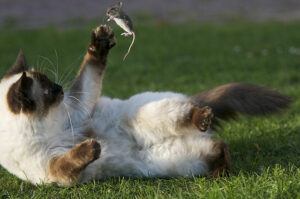
you happen to have a mouser you have seen just what efficient killers they are.
Knowing this actually helps us understand why they drive us so crazy running around at night. It’s not that they are nocturnal but that they have a different sleep-wake cycle from us and many other animals. This is primarily due to their need to hunt frequently and rest in between kills.
Feral cats will hunt 10-20 small prey in a 24-hour period, so expecting a cat to eat two square meals a day is a bit out of sync with their biology. Cats are used to eating small frequent meals and having to work for it.
Which Will It Be? Wet Food Or Dry Food?
One of the big questions about cat food is the wet food vs. dry food debate. You have likely heard that wet food is better and that is generally correct. Domestic cats are descended from desert dwellers and are therefore used to dealing with a low water intake. Wild/feral cats generally get 70-80% of their daily water intake from their prey and are not big water drinkers.
Canned food contains about 78%water whereas dry food contains 5-10% water, making canned food a closer approximation to a cat’s natural prey. When cats don’t get enough water is when we tend to see urinary issues in cats, with highly concentrated urine creating a higher risk for urinary crystals and bladder stones.
What Food Composition Is Best?
Looking at a cat’s natural prey can also tell us about the food composition that is best for them.
Generally, rodents contain about 55% protein, 45% fat and 1-2% carbohydrates, so for healthy cats a high protein and low carbohydrate diet is best (this recommendation changes some in cats with kidney disease).
We typically look for a diet that is <10% carbohydrates for healthy cats. In addition, cats need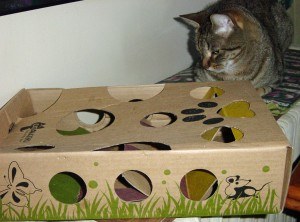 animal protein vs plant based protein since there are certain amino acids that cats cannot synthesize on their own and must get from their food.
animal protein vs plant based protein since there are certain amino acids that cats cannot synthesize on their own and must get from their food.
Expecting cats to eat two large meals a day, especially two carbohydrate heavy meals, can contribute to obesity as well as behavioral issues as it then leaves them with a lot of extra time on their hands.
I realize none of us have the time to feed our cats 10-20 small meals a day and leaving wet food out for grazing just doesn’t work well. So this is one instance when dry food can come in handy when used with something like a puzzle feeder (though there are also some puzzle feeders for wet food).
Puzzle Feeders Can Be Very Helpful
Using a puzzle feeder provides great enrichment for your cat and taps into their need to work for their food. A great resource for different types of puzzle feeders is http://foodpuzzlesforcats.com
Feeding our cats appropriately can help reduce obesity and subsequently diabetes risk, reduce
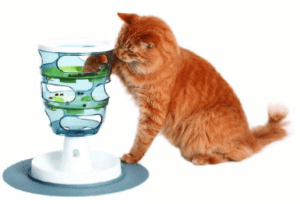 urinary issues, provide enrichment and reduce boredom. Coming up with a feeding plan that incorporates primarily wet food as well as small frequent meals that have some element of enrichment or “having to work for it” can greatly improve your cat’s physical and emotional health.
urinary issues, provide enrichment and reduce boredom. Coming up with a feeding plan that incorporates primarily wet food as well as small frequent meals that have some element of enrichment or “having to work for it” can greatly improve your cat’s physical and emotional health.
Resources:
Sadek T et al. AAFP Consensus Statement. Addressing behavioral needs to improve feline health and wellbeing. Journal of Feline Medicine and Surgery (2018) 20, 1049-1055.
Armstrong PJ, Gross KL, et al. Introduction to feeding normal cats. In: Hand MS, Thatcher CD, Remillard RL, Roudebush P, Novotny BJ, eds. Small Animal Clinical Nutrition, 5th ed. Topeka, KS: Mark Morris Institute, 2010.
Hamper B, Bartges J, Kirk C, et al. The unique nutritional requirements of the cat: a strict carnivore. In: Little S, ed. The Cat: Clinical Medicine and Management, St. Louis, MO: Elsevier Saunders; 2012.
Bartges J, Raditic D, Kirk C, et al. Nutritional management of disease. In: Little S, ed. The Cat: Clinical Medicine and Management. St. Louis, MO: Elsevier Saunders, 2012.

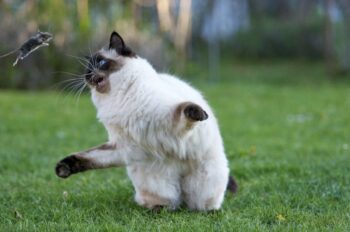
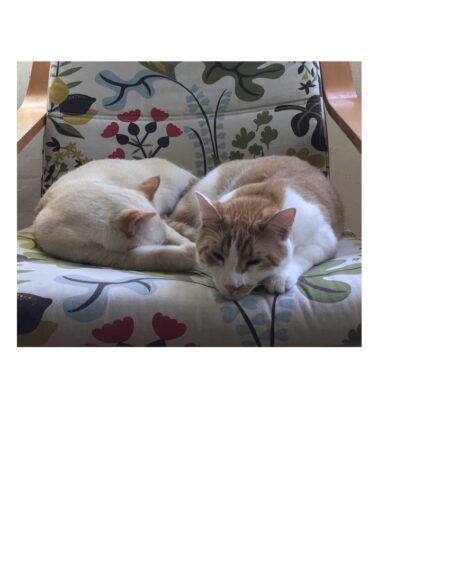
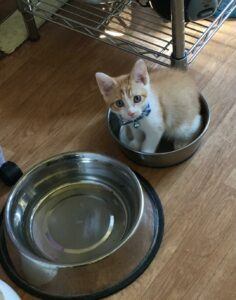
Great article! I love hunting feeders for my cat.
They are a good idea — glad someone thought of them. It is a good article, isn’t it? I’m hoping Susan will give us a regular taste of her expertise in our blogs. It’s a nice addition.
What do you do with a cat who want’s “Nothing” of the wet food, but pesters us all day long to ‘feed her.’ (“Nothing tastes good. I only want Salmon pate but I only want 3 bites and (off a spoon… no less) and then I’ll come and beg again 15 minutes later for another 3 bites.” Yes, she is spoiled. Yes she also has Canidae and Nutrish dry food but only eats this during the night. She hates shreds, chunks or gravy types. Companies are making fewer salmon pate choices. I’m at my wit’s end! She weighs 7 lbs 8 oz.
Wow, and I thought I had a problem! I often have to coax Pogo to eat; hold the dish up for him so he doesn’t have to bend so far. Lately, have been heating it for a few seconds in the microwave and he thinks that’s the cat’s pajamas. Pogo is just the opposite — if it has gravy, he’s for it. He can’t chew anything very big any more, though, so I mash up all his food. Talk about giving lots of small meals — I believe you have the award on that one.
Great information I didn’t know!
Good — you learned something new. That’s a good thing. Glad you enjoyed her post. I’m hoping she will do one fairly regularly.